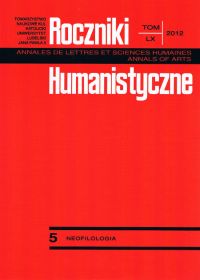From Figurative Representations to Metaphoric Deformations: The Iconic Text Layout in Contemporary Narrative Fiction in English
Abstrakt
Od przedstawień figuratywnych do metaforycznych zniekształceń. Ikoniczny układ graficzny tekstu we współczesnej prozie anglojęzycznej
Celem artykułu jest analiza procesu semiotyzacji układu graficznego tekstu w prozie narracyjnej i wykazanie, że różne konfiguracje grafemów mogą być skorelowane z głównymi typami ikoniczności wyróżnianymi w badaniach semiotycznych. Figuratywne przedstawienie typograficzne rekina-pożeracza myśli w powieści Pożeracz myśli Stevena Halla jest przykładem obrazowego znaku ikonicznego, który odzwierciedla jego szczególny status ontologiczny. Równoległe kolumny tekstu wykorzystane w powieści B. S. Johnsona Albert Angelo można zinterpretować jako diagramatyczne przedstawienie procesów zachodzących jednocześnie na poziomie świata przedstawionego. Z kolei w powieści Podwójna wygrana jak nic Raymonda Federmana nagromadzenie zniekształceń typograficznych, które obejmują zarówno ostentacyjnie ikoniczne formy, jak również czysto arbitralne układy tekstu, stanowi złożoną metaforę ikoniczną procesu twórczego. Podczas gdy struktura diagramatyczna wykorzystana w powieści Albert Angelo przekazuje znaczenie jedynie za pomocą środków typograficznych, pozostałe dwie powieści opierają się na nieuniknionej wzajemnej zależności między ikonicznym i symbolicznym trybem tworzenia znaczeń.
Bibliografia
Amos, Lisbeth Rieshøj. “Noodling Around: on a Frame-breaking [De]Tour Through Federman’s Surfictions.” Federman Frenzy: the Cult in Culture the Me in Memory the He in Hisstory - Encounters with Raymond Federman. Ed. Camelia Elias. Dept. of Language and Culture, Aalborg University, 2008. 11-20.
Bohn, Willard. Modern Visual Poetry. Newark: University of Delaware Press, 2001.
Cornis-Pope, Marcel. “Narrative (Dis)articulation and the Voice in the Closet Complex in Raymond Federman’s Fictions.” Critique: Studies in Contemporary Fiction 29.2 (1988): 77-93.
Di Leo, Jeffrey R., ed. Federman’s Fictions: Innovation, Theory, and the Holocaust. Albany: State University of New York Press, 2011.
Elleström, Lars. “Iconicity as Meaning Miming Meaning and Meaning Miming Form.” Signergy. Iconicity in Language and Literature 9. Ed. Jac Conradie et al. Amsterdam and Philadelphia: John Benjamins, 2010. 73-100.
Federman, Raymond. Double or Nothing. Chicago: Swallow Press, 1971.
Fischer, Olga and Max Nänny. “Introduction: Iconicity and Nature.” European Journal of English Studies 5.1 (2001): 3-16
Gerdes, Eckhard. “Raymond Federman, the Ultimate Metafictioneer.” In Di Leo, 127-142.
Hall, Steven. The Raw Shark Texts. Edinburgh: Cannongate, 2007.
Hayles, N. Katherine. “Material Entanglements: Steven Hall’s The Raw Shark Texts as Slipstream Novel.” Science Fiction Studies 38.1 (2011): 115-133.
Johansen, J. D. “Iconicity in Literature.” Semiotica 110.1/2 (1996): 37-55.
Johnson, B. S. Albert Angelo. 1964. In B. S. Johnson Omnibus. London: Picador, 2004.
Kutnik, Jerzy. “Tłumacz po słowie.” Raymond Federman. Podwójna wygrana jak nic. Kraków: Korporacja Ha!Art, 2010. i-viii.
Kutnik, Jerzy. The Novel as Performance: the Fiction of Ronald Sukenick and Raymond Federman. Carbondale and Edwardsville: Southern Illinois University Press, 1986.
Levenston, E. A. The Stuff of Literature: Physical Aspects of Texts and their Relation to Literary Meaning. Albany: State University of New York Press, 1992.
Malmgren, Carl Darryl. Fictional Space in the Modernist and Postmodernist American Novel. Lewisburg: Bucknell University Press, 1985.
Maziarczyk, Grzegorz. “Narrative Multivocality and Iconicity in Contemporary Fiction in English.” Roczniki Humanistyczne KUL 58.5 (2010): 169-179.
McHale, Brian. Postmodernist Fiction. London and New York: Methuen, 1987.
Mitchell, W. J. T. Iconology: Image, Text, Ideology. Chicago: University of Chicago Press, 1986.
Nöth, Winfried. “Semiotic Foundations of Iconicity in Language and Literature.” The Motivated Sign. Iconicity in Language and Literature 2. Ed. Olga Fischer & Max Nänny. Amsterdam and Philadelphia: John Benjamins, 2001. 17–28.
Peirce, Charles Sanders. Collected Papers of Charles Sanders Peirce. Ed. Charles Hartshorne and Paul Weiss, vols. 1-6; ed. Arthur W. Burks, vols. 7-8. Cambridge. Mass.: Harvard University Press. 1931-1958.
Suleiman, Susan Rubin. “When Postmodern Play Meets Survivor Testimony: Federman and Holocaust Literature.” In Di Leo, 215-227.
Thielemans, Johan. “‘Albert Angelo’ or B. S. Johnson’s Paradigm of Truth.” Review of Contemporary Fiction 5.2 (1985): 81-87.
White, Glyn. Reading the Graphic Surface: the Presence of the Book in Prose Fiction. Manchester and New York: Manchester University Press, 2005.
Wielgosz, Anne-Kathrin. “Displacement in Raymond Federman’s Double or Nothing or: ‘noodles and paper coincide’.” Journal of Narrative Technique 25.1 (1995): 91–107.
Copyright (c) 2012 Roczniki Humanistyczne

Utwór dostępny jest na licencji Creative Commons Uznanie autorstwa – Użycie niekomercyjne – Bez utworów zależnych 4.0 Międzynarodowe.





